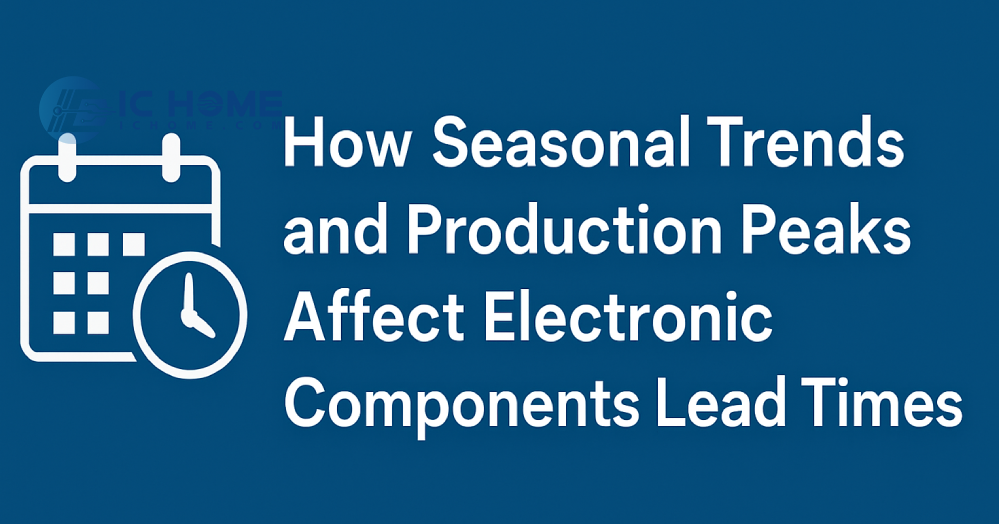How Seasonal Trends and Production Peaks Affect Electronic Components Lead Times
For procurement professionals and supply chain managers in the electronics industry, understanding and managing lead times is a constant balancing act. In an industry defined by rapid innovation and tight production schedules, delays in component deliveries can create costly bottlenecks. While some delays may stem from market shortages or manufacturing issues, a significant portion is due to seasonal trends and production peaks. These cyclical disruptions are predictable, yet many buyers underestimate their impact — until it's too late.

1. Holiday Seasons and Their Disruptive Power
Certain global holidays have an outsized impact on the electronics supply chain. Chief among them is Lunar New Year, typically falling between January and February. During this period, manufacturing hubs in China, Taiwan, Vietnam, and other Asian countries shut down for up to two weeks or more. As these regions produce a large portion of the world’s electronic components — from passive parts like capacitors and resistors to semiconductors and connectors — the halt in operations can cause weeks of delays.
But that’s not the only seasonal disruption. In North America and Europe, the Christmas and New Year holidays also slow down logistics operations. Reduced warehouse staff, limited freight availability, and port congestion are common in December and early January. If orders are not placed well in advance, shipments can be delayed into Q1 of the following year.
2. Year-End Budget Rush and Procurement Spikes
Many companies align their fiscal years with the calendar year. As a result, Q4 becomes a high-pressure period for procurement teams who need to spend remaining budgets or meet annual production targets. This surge in last-minute orders causes supply chain congestion, particularly in November and December. Suppliers and distributors may struggle to fulfill all requests, leading to prioritization of high-volume or long-term customers.
Moreover, the increased demand can drive up component prices, especially for in-demand products like MCUs, power management ICs, memory chips, and analog components. Buyers who delay purchases until the year-end may find themselves facing both longer lead times and higher costs.
3. Production Peaks: When Demand Outpaces Supply
Beyond seasonal holidays, production peaks linked to industry cycles can create supply chain stress. For example, the consumer electronics sector typically ramps up production in Q2 and Q3 to prepare for back-to-school and holiday season launches. Similarly, the automotive industry often plans production bursts around model-year rollouts.
When several industries simultaneously increase their manufacturing volumes, component suppliers experience a surge in demand that can exceed capacity. Lead times for components like sensors, embedded processors, and MLCCs can stretch from a few weeks to several months — even for long-standing customers.
This dynamic is especially challenging for OEMs and EMS providers who rely on just-in-time delivery models. During peak periods, factory scheduling is tight, and missing one critical component can stall an entire product line.
4. How to Prepare: Practical Steps for Lead Time Risk Mitigation
While seasonal and cyclical challenges are hard to eliminate, they are highly predictable — and that means they can be planned for. Here are key strategies for staying ahead:
a. Advance Procurement Planning
-
Anticipate long lead times by placing orders 2–3 months ahead of major holidays or production peaks.
-
Work closely with sales reps or authorized distributors, like ICHOME, to receive forecast alerts and availability trends.
b. Use Rolling Forecasts
-
Implement 6–12-month rolling forecasts based on historical consumption and sales projections.
-
Share forecasts with key suppliers to reserve production slots or buffer stock.
c. Build Buffer Inventory
-
Keep safety stock of critical or long-lead-time components, particularly those with unstable supply (e.g., FPGAs, high-end MCUs).
-
If storage space or cash flow is limited, explore vendor-managed inventory (VMI) programs.
d. Diversify Supply Sources
-
Avoid single-source dependency by qualifying alternate brands or regional suppliers.
-
Use a mix of authorized distributors, independent brokers, and franchised partners to increase flexibility.
e. Monitor Global Events
-
Stay informed on geopolitical risks, weather disruptions, or strikes that can compound seasonal delays.
-
Subscribe to supply chain intelligence tools or updates from key suppliers.
Conclusion: Timing is Procurement’s Silent Advantage
While pricing and technical specifications often dominate procurement decisions, timing is a hidden but powerful variable. By understanding the seasonal and cyclical forces at play in the electronics supply chain, buyers can avoid last-minute scrambles, missed deadlines, and costly delays.
Proactive planning is not just a best practice — it’s a competitive edge. The companies that forecast demand, secure supply early, and adapt to the rhythms of the market will always stay one step ahead, especially when others are caught off guard by predictable — yet disruptive — seasonal forces.




